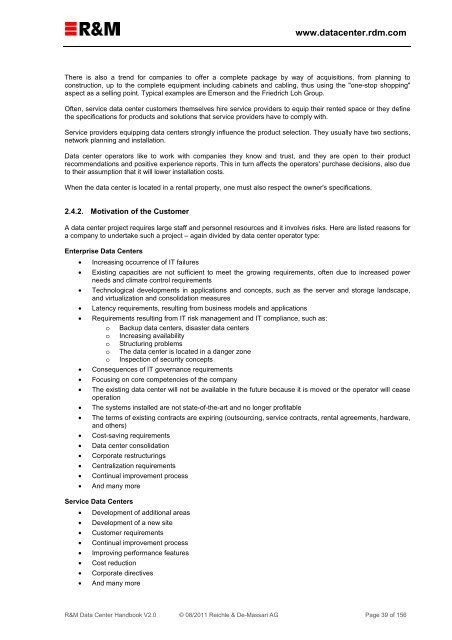R&M Data Center Handbook
R&M Data Center Handbook
R&M Data Center Handbook
Create successful ePaper yourself
Turn your PDF publications into a flip-book with our unique Google optimized e-Paper software.
www.datacenter.rdm.com<br />
There is also a trend for companies to offer a complete package by way of acquisitions, from planning to<br />
construction, up to the complete equipment including cabinets and cabling, thus using the "one-stop shopping"<br />
aspect as a selling point. Typical examples are Emerson and the Friedrich Loh Group.<br />
Often, service data center customers themselves hire service providers to equip their rented space or they define<br />
the specifications for products and solutions that service providers have to comply with.<br />
Service providers equipping data centers strongly influence the product selection. They usually have two sections,<br />
network planning and installation.<br />
<strong>Data</strong> center operators like to work with companies they know and trust, and they are open to their product<br />
recommendations and positive experience reports. This in turn affects the operators' purchase decisions, also due<br />
to their assumption that it will lower installation costs.<br />
When the data center is located in a rental property, one must also respect the owner's specifications.<br />
2.4.2. Motivation of the Customer<br />
A data center project requires large staff and personnel resources and it involves risks. Here are listed reasons for<br />
a company to undertake such a project – again divided by data center operator type:<br />
Enterprise <strong>Data</strong> <strong>Center</strong>s<br />
• Increasing occurrence of IT failures<br />
• Existing capacities are not sufficient to meet the growing requirements, often due to increased power<br />
needs and climate control requirements<br />
• Technological developments in applications and concepts, such as the server and storage landscape,<br />
and virtualization and consolidation measures<br />
• Latency requirements, resulting from business models and applications<br />
• Requirements resulting from IT risk management and IT compliance, such as:<br />
o Backup data centers, disaster data centers<br />
o Increasing availability<br />
o Structuring problems<br />
o The data center is located in a danger zone<br />
o Inspection of security concepts<br />
• Consequences of IT governance requirements<br />
• Focusing on core competencies of the company<br />
• The existing data center will not be available in the future because it is moved or the operator will cease<br />
operation<br />
• The systems installed are not state-of-the-art and no longer profitable<br />
• The terms of existing contracts are expiring (outsourcing, service contracts, rental agreements, hardware,<br />
and others)<br />
• Cost-saving requirements<br />
• <strong>Data</strong> center consolidation<br />
• Corporate restructurings<br />
• Centralization requirements<br />
• Continual improvement process<br />
• And many more<br />
Service <strong>Data</strong> <strong>Center</strong>s<br />
• Development of additional areas<br />
• Development of a new site<br />
• Customer requirements<br />
• Continual improvement process<br />
• Improving performance features<br />
• Cost reduction<br />
• Corporate directives<br />
• And many more<br />
R&M <strong>Data</strong> <strong>Center</strong> <strong>Handbook</strong> V2.0 © 08/2011 Reichle & De-Massari AG Page 39 of 156


